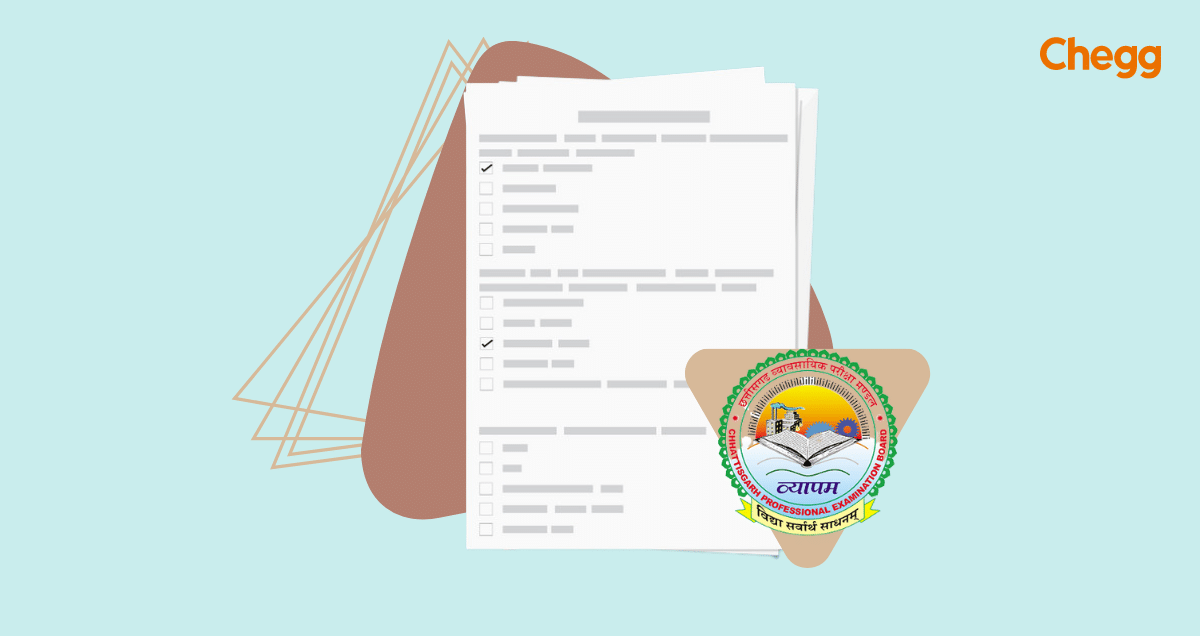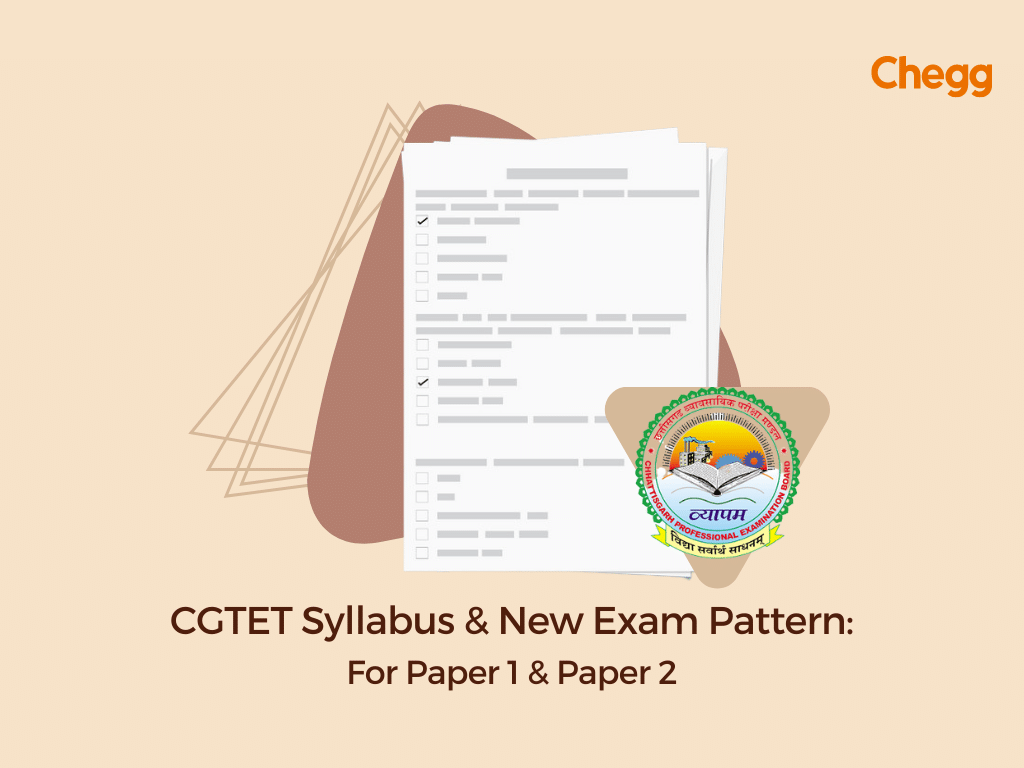CG TET Syllabus & Exam Pattern 2024: Paper 1 & Paper 2

Table of Contents
Table of Contents
The Chhattisgarh Teacher Eligibility Test (CGTET) is conducted by Chhattisgarh Professional Examination Board (CPEB) to recruit teachers for state government schools. The exam is held in two phases. Paper 1 is conducted for teachers of primary level (Classes I to V). Paper 2 is conducted for teachers of higher level (Classes VI to VIII). Aspiring candidates can review the CGTET syllabus 2022 to prepare for the exam.
The candidates need to understand the exam pattern and the syllabus of the CGTET exam. This would help them to prepare appropriately for the exam.

CG TET Syllabus 2024
The CGET exam is conducted in two phases. Let’s look at the subjects for both papers.
CG TET Syllabus Paper 1
The CG TET syllabus for Paper 1 incorporates the below-listed subjects:
- Mathematics
- Child Development & Pedagogy.
- Language I (Hindi)
- Language II (English)
- Environmental studies.
CG TET Subjects Paper 2
The CG TET syllabus for Paper 2 incorporates the below-listed subjects:
- Mathematics & Science/ Social Science
- Child Development & Pedagogy.
- Language I (Hindi)
- Language II (English)

CG TET Selection Process 2024
- The CGTET exam is conducted in two phases. The first phase is the written round. The second round is the interview round.
| Subject | Questions | Marks |
| Mathematics | 30 | 30 |
| Child Development & Pedagogy | 30 | 30 |
| Language I (Hindi) | 30 | 30 |
| Language II(English) | 30 | 30 |
| Environmental Studies | 30 | 30 |
| Total | 150 | 150 |
- The written round is conducted in offline mode and is objective-based.
- Paper 1 is conducted for primary-level teachers (Classes I – V).
- Paper 2 is conducted for higher-level teachers (Classes VI-VIII).
Exam Pattern of CG TET for Paper 1
- The CG TET exam for paper 1 is offline and objective-based.
- The total time of the paper is 2 hours and 30 minutes.
- No marks are deducted for wrong or un-attempted questions.
- One mark is awarded for every correct answer.
Exam Pattern of CG TET for Paper 2
| Subject | Questions | Marks |
| Mathematics & Science/Social Science | 60 | 60 |
| Child Development & Pedagogy | 30 | 30 |
| Language I(Hindi) | 30 | 30 |
| Language II(English) | 30 | 30 |
| Total | 150 | 150 |
- The CG TET exam for paper 2 is offline and objective-based.
- The total time of the paper is 2 hours and 30 minutes.
- No marks are deducted for wrong or unattempted questions.
- One mark is awarded for every correct answer.
- Teachers opting for Maths & Science have to attend the Mathematics & Science paper, while the Social science teacher has to attend the Social Science paper.
Detailed CGTET Syllabus Paper 1
| CG TET Syllabus for Mathematics | • Teaching, learning & evaluation of maths. • Nature of mathematics. • Decimal system. • Number system. • Simplification. • Square root. • HCF & LCM. • Percentage. • Average. • Simple Interest. • Profit & Loss. • Unity law. • Time & Distance. • Area & Volume. • Time. • Ratio & Proportion. |
| CG TET Syllabus for Child Development & Pedagogy | • Introduction to Child Development. • Dimension of development. • Children with special needs. • Learning & Cognitive development. |
| CG TET Syllabus for Language I (Hindi) | • Shabd vichar. • Varna vichar. • Shabd Rachana. • Vakhya parichay. • Pad wa pad bhed. • Rachana. • Mulyankan. • Bacchae ki Bhashaae kshamata avom unka vichar |
| CGTET Syllabus for Language II (English) | • Vocabulary. • Reading comprehension. • Grammar. • Pedagogy of language development. • Unseen passage. |
| CG TET Syllabus for Environmental studies | • Understanding of children on environment. • Understanding our environment. • The importance of environmental studies. • The teaching of social studies. • Environmental studies & classroom activities. • Ecological studies. • Family. • Care of one’s own body |
Detailed CGTET Syllabus Paper 2
| CG TET Syllabus for Mathematics & Science | • Teaching, learning & evaluation of maths. • Nature of mathematics. • Decimal system. • Number system. • Number series. • BODMAS. • Simplification. • Square root. • HCF & LCM. • Percentage. • Average. • Simple & Compound Interest. • Profit & Loss. • Unity law. • Time & Distance. • Area & Volume. • Time. • Triangle. • Parallelogram. • Rectangle. • Trapezium. • Ratio & Proportion. • Planes. • Line & Angles. • Data Interpretations & statistics. Science • Living things. • Heat • Light • Sound & magnetism. • Force & motion. • Electricity • Science & technology. • The structure of matter and chemical substances. |
| CGTET Syllabus for Social science | • Indian culture & heritage. • Mughal dynasty. • Bhakti & Sufi movement. • Indian society. • Indian constitution. • British period. • Earth and its components. • Regulatory, executory & judicial systems. • Study of India. • Geography, history & culture of Chhattisgarh. • Pedagogical issues. |
| CG TET Syllabus for Child Development & Pedagogy | • Development of primary school child. • Children with special needs. • Inclusive education. • Learning & pedagogy. |
| CG TET Syllabus for Language I (Hindi) | • Shabd vichar. • Varna vichar. • Vakhya parichay. • Pad wa pad bhed. • Viram Chinha pramukha prakhar. • Rachana. • Apathit gadyansh. • Bhashyen kaushal ka Udyapan. |
| CG TET Syllabus for Language II (English) | • Pedagogy of language development. • Grammar • Vocabulary • Reading comprehension. • Unseen passage. |
- There is no update regarding the change in the CGTET 2023 syllabus for paper 2. So, the candidates can prepare according to the CGTET syllabus 2022.
CGTET Exam – Passing Marks
The passing marks for the CG TET exam 2023 have not been announced. The candidates are advised to regularly visit the official website of CPEB for the latest information. Meanwhile, let’s look at the passing marks for the CG TET exam 2022.
| Category | Minimum marks | Minimum questions | Percentage |
| SC/ST/PwD | 60 | 60 | 40% |
| OBC | 70 | 70 | 50% |
| General | 90 | 90 | 60% |
- The cut-off marks depend on several factors. Some of them are:
- The difficulty level of the question paper.
- The number of candidates appearing for the exam.
- The number of vacancies.
Conclusion
The CGTET exam is conducted annually to recruit candidates for the posts of teachers in state government schools. The exam is conducted in two phases. Paper 1 is conducted for teachers of primary level (Classes I -V). Paper 2 is conducted for teachers for higher levels (Classes VI-VIII).
Aspiring candidates should know the CGTET syllabus and the exam pattern in advance. This would help them to prepare for the exam properly. With this awareness, they would focus on those topics for the exam.
The candidates selected through CGTET have excellent career growth. They would get regular promotions, and some ended their career as headmasters. The teachers are entitled to handsome salaries with several perks and benefits. These should motivate the candidates to prepare seriously for the CGTET exam.
Frequently Answered Questions (FAQs)
How can I prepare for CGTET?
Prepare a study plan, choose the right books, revise the topics, practice mock papers, and solve previous year’s papers to prepare for the exam.
What are the passing marks for CGTET?
The passing marks for the CGTET exam 2023 have not been announced. The passing marks for 2022 were 40% (60 marks) for SC/ST/PwD, 50% (70 marks) for OBC, and 60% (90 marks) for General candidates.
Who is eligible for CGTET?
For paper 1, the candidates have to clear Class 12 with a minimum of 50% marks. They should have completed their graduation with BA/B.Ed/B.Sc with a minimum of 50% marks. For paper 2, the candidates should have completed their graduation in BA/B.Ed/B.Sc with a minimum of 50%. The candidates who have completed their 2-year D.El.Ed (Diploma in Elementary Education) can apply.
Is there any negative marking in CGTET?
There are no negative marks for wrong answers in the CGTET exam.
Which exam is tough – TET or CGTET?
CGTET is easy to clear as compared to the TET exam.
Which subject is best for the TET exam?
The subjects for the TET exam are Child Development and Pedagogy, Language I & II, mathematics & science, environmental studies, and social science.